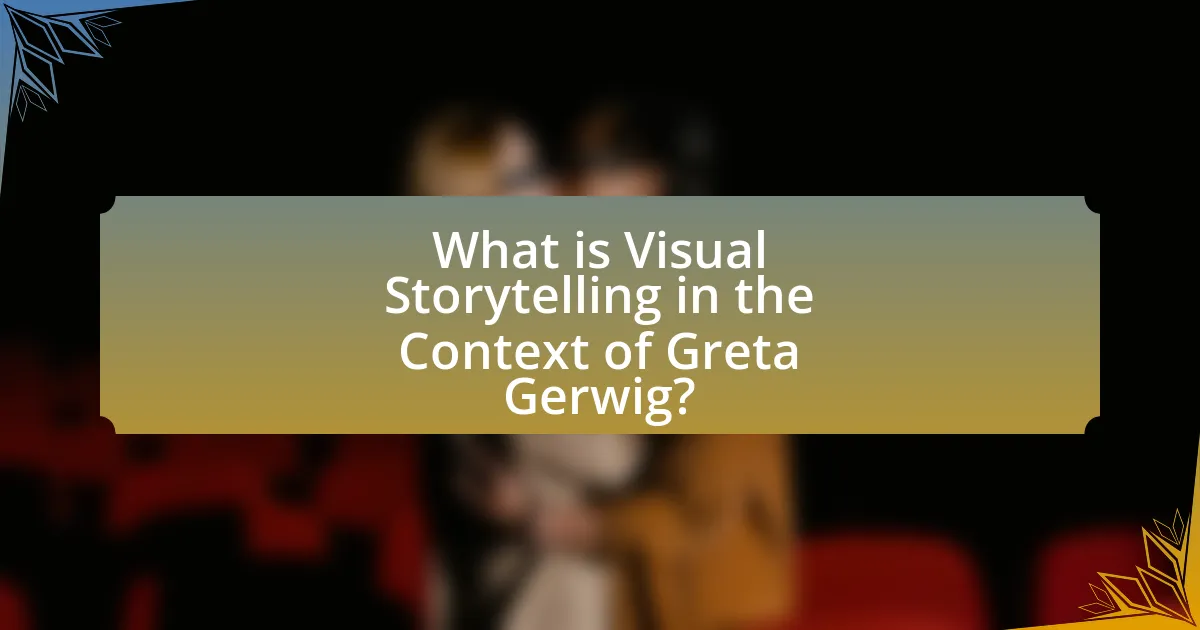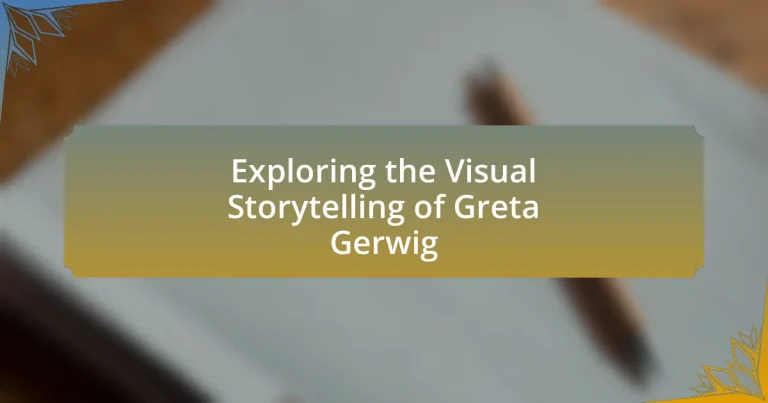Greta Gerwig is a prominent filmmaker known for her distinctive visual storytelling techniques that enhance emotional depth and character development in her films. This article explores Gerwig’s use of color, composition, and cinematography, highlighting how these elements contribute to narrative themes and character arcs in works such as “Lady Bird” and “Little Women.” Key insights include her methods for conveying emotions visually, the significance of color symbolism, and the evolution of her visual style across her filmography. Additionally, the article examines how Gerwig’s visual storytelling reflects cultural and social themes, offering practical insights for emerging filmmakers on enhancing narrative impact through visual elements.

What is Visual Storytelling in the Context of Greta Gerwig?
Visual storytelling in the context of Greta Gerwig refers to her unique ability to convey narratives through visual elements, such as color, composition, and cinematography, which enhance emotional depth and character development in her films. Gerwig employs vibrant color palettes and meticulous framing to evoke specific moods and themes, as seen in “Lady Bird” and “Little Women,” where visual choices reflect the characters’ inner lives and societal contexts. For instance, in “Little Women,” the contrasting visual styles between the sisters’ childhood and adulthood visually represent their differing paths and aspirations, demonstrating Gerwig’s mastery in using visuals to enrich storytelling.
How does Greta Gerwig define visual storytelling in her films?
Greta Gerwig defines visual storytelling in her films as a means to convey emotional depth and character development through carefully crafted imagery and composition. She emphasizes the importance of visual elements, such as color, framing, and movement, to enhance narrative themes and character arcs. For instance, in “Lady Bird,” the use of vibrant colors and specific locations reflects the protagonist’s emotional journey and personal growth, demonstrating how visual choices can significantly impact storytelling.
What techniques does she use to convey emotions visually?
Greta Gerwig employs techniques such as color palettes, framing, and expressive performances to convey emotions visually. For instance, she utilizes vibrant color schemes to evoke specific feelings; warm tones often signify happiness or nostalgia, while cooler tones can indicate sadness or tension. Additionally, Gerwig’s strategic framing captures characters’ emotional states, using close-ups to highlight vulnerability or isolation. Her direction encourages actors to deliver nuanced performances, enhancing the emotional depth of scenes. These methods are evident in her films, where visual storytelling effectively communicates complex emotions without relying solely on dialogue.
How does her visual style reflect her narrative themes?
Greta Gerwig’s visual style reflects her narrative themes through vibrant color palettes and meticulous set designs that emphasize emotional depth and character development. For instance, in “Lady Bird,” the use of warm, nostalgic hues mirrors the protagonist’s longing for connection and identity, reinforcing the theme of adolescence and familial relationships. Additionally, Gerwig’s framing and composition often highlight the characters’ emotional states, such as the use of close-ups to capture intimate moments, which underscores themes of vulnerability and self-discovery. This intentional visual approach not only enhances the storytelling but also creates a cohesive experience that resonates with the audience, illustrating how her aesthetic choices are intricately linked to the narratives she explores.
Why is visual storytelling important in Gerwig’s work?
Visual storytelling is important in Gerwig’s work because it enhances emotional engagement and character development. Gerwig employs vibrant color palettes, dynamic camera angles, and meticulous set designs to create immersive worlds that resonate with audiences. For instance, in “Little Women,” the use of contrasting visual styles between the past and present underscores the characters’ growth and the thematic exploration of female autonomy. This approach not only captivates viewers but also deepens their understanding of the narrative, making visual storytelling a crucial element in Gerwig’s filmmaking.
What role does visual storytelling play in character development?
Visual storytelling significantly enhances character development by providing a visual context that deepens audience understanding and emotional connection. Through the use of imagery, color, and composition, filmmakers like Greta Gerwig convey complex character traits and arcs without relying solely on dialogue. For instance, Gerwig’s use of contrasting visual elements in “Lady Bird” illustrates the protagonist’s internal conflicts and growth, allowing viewers to interpret her journey through visual cues. This method of storytelling engages the audience on a sensory level, making character experiences more relatable and impactful.
How does it enhance the audience’s connection to the story?
Visual storytelling enhances the audience’s connection to the story by creating immersive experiences that evoke emotional responses. Greta Gerwig employs vibrant colors, dynamic camera angles, and meticulous set designs to reflect characters’ inner emotions and themes, making the narrative more relatable. For instance, in “Lady Bird,” the use of warm tones during family interactions emphasizes the warmth and complexity of familial love, allowing viewers to resonate with the characters’ struggles and triumphs. This visual approach not only captivates the audience but also deepens their emotional investment in the storyline, fostering a stronger connection to the characters and their journeys.
What are the Key Elements of Greta Gerwig’s Visual Storytelling?
Greta Gerwig’s visual storytelling is characterized by vibrant color palettes, meticulous framing, and a strong emphasis on character emotions. Her use of color enhances the narrative, as seen in “Lady Bird,” where warm tones reflect the protagonist’s coming-of-age journey. Gerwig’s framing often captures intimate moments, allowing viewers to connect deeply with characters, exemplified in “Little Women,” where close-ups convey complex emotions. Additionally, her incorporation of dynamic camera movements creates a sense of energy and movement, further engaging the audience. These elements collectively contribute to a distinctive visual style that resonates with viewers and enhances the storytelling experience.
How does color symbolism feature in her films?
Color symbolism prominently features in Greta Gerwig’s films, enhancing emotional depth and character development. For instance, in “Lady Bird,” the use of green symbolizes growth and aspiration, particularly in scenes where Lady Bird dreams of leaving Sacramento. Additionally, the contrasting colors in “Little Women” reflect the characters’ personalities and societal roles, with muted tones representing the constraints placed on women in the 19th century, while vibrant colors signify their desires and individuality. This intentional use of color not only supports the narrative but also engages the audience on a visual and emotional level, making the themes more resonant.
What emotions do specific colors evoke in her narratives?
In Greta Gerwig’s narratives, specific colors evoke distinct emotions that enhance the storytelling experience. For instance, the use of warm colors like red and orange often conveys passion, energy, and warmth, creating an inviting atmosphere. Conversely, cooler colors such as blue and green can evoke feelings of calmness, introspection, or melancholy, reflecting the characters’ emotional states. This color symbolism is supported by psychological studies indicating that colors can significantly influence human emotions and perceptions, such as the research by Andrew Elliot and Markus Maier, which highlights how warm colors can stimulate feelings of excitement while cool colors promote tranquility.
How does color contribute to the overall mood of her films?
Color significantly contributes to the overall mood of Greta Gerwig’s films by establishing emotional tones and enhancing narrative themes. For instance, in “Lady Bird,” the use of warm, vibrant colors reflects the protagonist’s youthful exuberance and desire for freedom, while cooler tones in more somber scenes underscore feelings of conflict and introspection. This strategic color palette not only evokes specific emotional responses from the audience but also aligns with the film’s coming-of-age narrative, reinforcing the character’s journey. Gerwig’s deliberate color choices serve as a visual language that deepens the viewer’s connection to the story and its characters.
What role does cinematography play in her storytelling?
Cinematography plays a crucial role in Greta Gerwig’s storytelling by visually conveying emotions and themes that enhance the narrative. Through her use of color palettes, framing, and camera movement, Gerwig creates a distinct atmosphere that reflects the characters’ inner lives and the story’s emotional arcs. For instance, in “Lady Bird,” the warm color tones and intimate close-ups foster a sense of nostalgia and connection, allowing viewers to engage deeply with the protagonist’s journey. This visual approach not only supports the plot but also enriches the audience’s understanding of character dynamics and thematic elements, demonstrating the integral relationship between cinematography and storytelling in her films.
How do camera angles and movements influence viewer perception?
Camera angles and movements significantly influence viewer perception by shaping emotional responses and narrative understanding. For instance, low-angle shots can create a sense of power or dominance, while high-angle shots may evoke vulnerability or weakness. Additionally, dynamic camera movements, such as tracking or panning, can enhance the sense of immersion and urgency in a scene. Research indicates that specific angles and movements can manipulate audience emotions; for example, a study published in the Journal of Media Psychology found that viewers reported heightened anxiety during scenes with rapid camera movements compared to static shots. This evidence underscores the critical role that camera techniques play in guiding viewer interpretation and emotional engagement in visual storytelling.
What techniques does she employ to create visual rhythm?
Greta Gerwig employs techniques such as repetition, contrast, and movement to create visual rhythm in her storytelling. Repetition of visual motifs, such as colors or shapes, establishes a cohesive aesthetic that guides the viewer’s eye and reinforces thematic elements. Contrast, whether through lighting or composition, creates dynamic tension that enhances the visual experience. Additionally, the use of movement, both in camera work and character actions, contributes to a sense of flow and progression, allowing the audience to engage more deeply with the narrative. These techniques are evident in her films, where the interplay of these elements results in a compelling visual rhythm that captivates viewers.
How Does Greta Gerwig’s Visual Storytelling Evolve Across Her Films?
Greta Gerwig’s visual storytelling evolves significantly across her films, showcasing a progression from intimate, character-driven narratives to more expansive, stylized aesthetics. In her debut feature, “Lady Bird,” Gerwig employs a grounded, realistic visual style that emphasizes the protagonist’s personal journey through warm color palettes and naturalistic settings. This approach reflects her focus on character development and emotional resonance.
In contrast, her subsequent film, “Little Women,” introduces a more dynamic visual language, utilizing varied framing techniques and a richer color scheme to convey the distinct personalities of the March sisters and the passage of time. The use of non-linear storytelling and vibrant visuals enhances the thematic depth of the narrative, illustrating Gerwig’s growing confidence in manipulating visual elements to serve the story.
Most recently, in “Barbie,” Gerwig embraces a bold, surreal aesthetic characterized by vibrant colors and stylized production design, reflecting the film’s satirical tone and commentary on gender roles. This shift demonstrates her ability to adapt her visual storytelling to fit diverse narratives while maintaining a strong emotional core. Overall, Gerwig’s evolution in visual storytelling is marked by an increasing sophistication in her use of color, composition, and thematic depth, aligning her visual style with the narrative’s emotional and thematic complexities.
What are the notable differences in visual storytelling between her early and recent works?
Greta Gerwig’s early works, such as “Frances Ha,” emphasize a raw, intimate style that often utilizes handheld camera techniques and natural lighting to create a sense of realism and spontaneity. In contrast, her recent works, particularly “Little Women,” showcase a more polished and structured approach, employing elaborate set designs and a vibrant color palette to enhance emotional depth and narrative complexity. This evolution reflects Gerwig’s growth as a filmmaker, moving from a focus on personal, character-driven stories to a broader, more visually dynamic storytelling that incorporates intricate visual motifs and thematic layers.
How has her approach to visual storytelling changed over time?
Greta Gerwig’s approach to visual storytelling has evolved from a focus on intimate, character-driven narratives to a more expansive and stylized aesthetic. Initially, her films, such as “Frances Ha,” emphasized realism and personal experiences, showcasing a raw and relatable perspective. Over time, with projects like “Little Women” and “Barbie,” Gerwig incorporated vibrant visuals, intricate set designs, and a broader thematic scope, reflecting a shift towards a more imaginative and visually dynamic storytelling style. This transition illustrates her ability to blend personal storytelling with larger cultural narratives, enhancing the emotional and visual impact of her films.
What influences have shaped her evolving style?
Greta Gerwig’s evolving style has been shaped by a combination of personal experiences, cinematic influences, and cultural contexts. Her background in theater and literature informs her narrative approach, while filmmakers like Woody Allen and the French New Wave have inspired her visual storytelling techniques. Additionally, her collaborations with cinematographers and production designers have further refined her aesthetic, as seen in films like “Lady Bird” and “Little Women,” where she blends personal narrative with broader societal themes.
How do her films reflect cultural and social themes through visual storytelling?
Greta Gerwig’s films reflect cultural and social themes through visual storytelling by employing vibrant color palettes, symbolic imagery, and character-driven narratives that resonate with contemporary societal issues. For instance, in “Lady Bird,” Gerwig uses the protagonist’s journey to explore themes of identity, family dynamics, and the socio-economic challenges faced by young women, effectively capturing the nuances of adolescence and personal growth. Additionally, her adaptation of “Little Women” highlights gender roles and the pursuit of independence, utilizing visual motifs such as contrasting settings and costumes to emphasize the characters’ struggles against societal expectations. These techniques not only enhance the emotional depth of the stories but also invite audiences to engage with the cultural contexts presented, making her films a reflection of modern social themes.
What visual motifs recur in her exploration of gender and identity?
Greta Gerwig frequently employs visual motifs such as color symbolism, mirrors, and domestic spaces in her exploration of gender and identity. Color symbolism, particularly the use of pink and blue, reflects societal expectations and stereotypes associated with femininity and masculinity. Mirrors serve as a motif to illustrate self-reflection and the duality of identity, emphasizing the internal struggles characters face regarding their gender roles. Additionally, domestic spaces are often depicted to highlight the intersection of personal and societal expectations, showcasing how environments shape identity. These motifs collectively reinforce the complexities of gender and identity in Gerwig’s narratives.
How does she use visual storytelling to comment on societal issues?
Greta Gerwig uses visual storytelling to comment on societal issues by incorporating relatable characters and vivid imagery that reflect contemporary social dynamics. In her films, such as “Lady Bird” and “Little Women,” she addresses themes like gender roles, family dynamics, and personal identity, using visual metaphors and symbolic settings to enhance these narratives. For instance, in “Lady Bird,” the contrasting settings of Sacramento and the elite private school serve to highlight class disparities and the protagonist’s struggle for self-identity. Gerwig’s attention to detail in costume and set design further emphasizes these societal themes, making her commentary both accessible and impactful.
What practical insights can filmmakers learn from Greta Gerwig’s visual storytelling?
Filmmakers can learn the importance of character-driven visuals from Greta Gerwig’s storytelling approach. Gerwig effectively uses color palettes, framing, and composition to reflect her characters’ emotional states and development, as seen in “Lady Bird,” where warm tones evoke nostalgia and intimacy. Additionally, her use of visual motifs, such as the recurring imagery of flight in “Little Women,” reinforces themes of freedom and aspiration. This strategic visual language enhances narrative depth and audience engagement, demonstrating that thoughtful visual choices can significantly elevate storytelling in film.
What techniques can emerging filmmakers adopt from her style?
Emerging filmmakers can adopt techniques from Greta Gerwig’s style, such as her use of vibrant color palettes and meticulous attention to character development. Gerwig often employs a distinct visual aesthetic that enhances emotional resonance, utilizing colors to reflect characters’ inner states and the narrative’s tone. Additionally, her focus on authentic dialogue and nuanced performances allows for deeper character connections, which can be achieved through careful casting and rehearsal processes. By integrating these elements, filmmakers can create visually compelling and emotionally engaging stories that resonate with audiences.
How can visual storytelling enhance narrative impact in independent films?
Visual storytelling enhances narrative impact in independent films by creating a deeper emotional connection between the audience and the characters. This technique utilizes visual elements such as cinematography, color palettes, and composition to convey themes and emotions that dialogue alone may not express. For instance, in Greta Gerwig’s films, the use of vibrant colors and unique framing often reflects the internal struggles of her characters, allowing viewers to engage with their journeys on a more visceral level. Studies show that visual cues can significantly influence audience perception and retention, making the narrative more memorable and impactful.


